#embryology notes
Photo


#studyblr#notes#medblr#medical notes#med notes#y chromosome#y chromosome notes#chromosomes#chromosome notes#development#embryology#embryology notes#genetics#genetics notes#notes on genetics#x chromosome#x chromosome notes
21 notes
·
View notes
Text
Let's Talk Sea Slugs: Rostanga pulchara
Rostanga pulchara is a small species of dorid nudibranch commonly found grazing on the red sponges that give it its color.
The adult below was 16mm long and 8mm wide, but they can grow to as large as 33mm long (Jensen et al 2018).
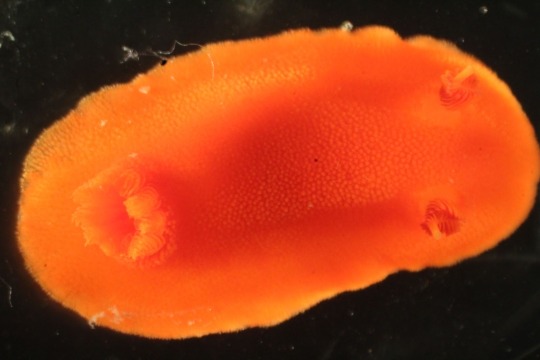
Above - Adult Rostanga pulchara collected from Cattle Point Intertidal, San Juan Island by Babonis Lab, Summer 2022.

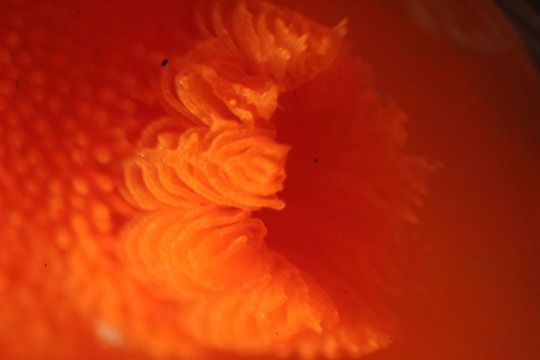

Above - Closeups of Rostanga pulchara. Left - mantle showing the texture and shape of the tubercles. Center - gills. Right - rhinophore.
Along with size and color, a defining characteristic of the nudibranch is its uniquely shaped rhinophores (Jensen et al 2018). One is pictured above on the right.
A good way to find them in the wild is to look for the sponges that they eat. Two of these species are the velvety Clathria pennata and the "volcano-shaped" Acarnus erithacus (Jensen et al 2018). Both sponges are encrusting and highly pigmented.
The pigments from the sponge not only color the adult nudibranchs, but also their eggs (Jensen et al 2018). This can be seen in the early embryos below.
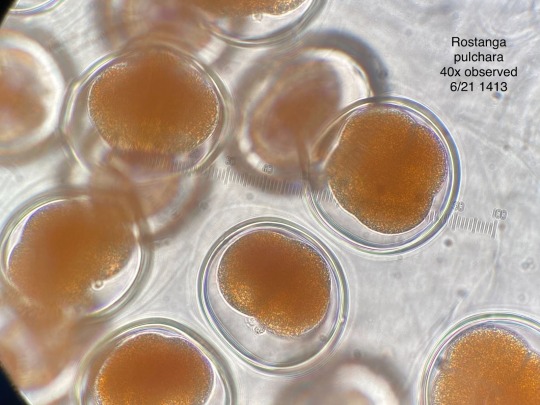
Above - Rostanga pulchara embryos, 2-cell and 4-cell stages. Viewed on 6/21/2022 under 40x magnification. The center 2-cell embryo was 111 microns across.
A week and a half later, these embryos had developed close to the point of hatching.
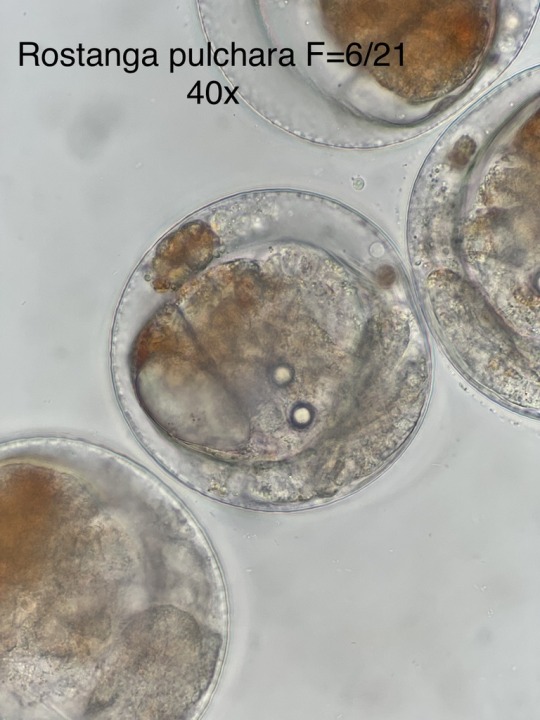
Unhatched veliger larvae, with visible shell anViewed on 7/1/2022 under 40X magnification. The center embryo measured at 125 microns across.
These nudibranchs, like many others, have a larval form called veligers. These veligers have shells and big ciliated lobes.

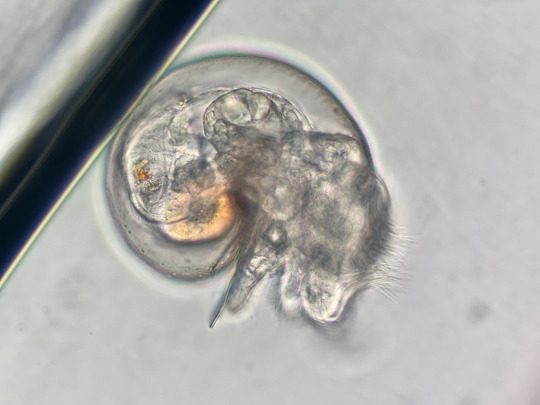
Hatched veliger larvae. Viewed on 7/7/2022 under 40X magnification.
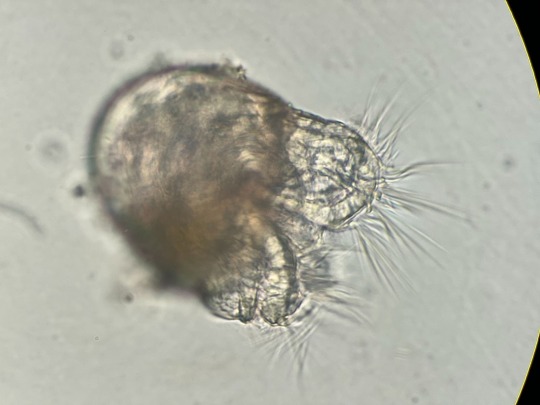


Hatched veliger larvae from the same clutch of original eggs. Viewed on 7/13/2022 under 20X magnification. The larvae on the right was measured as 194 microns across the veler lobes and 178 micros from the top of the shell down to where the veler lobes exit the shell.
Sources:
Personal lab notes and obervations.
Jensen et al. Beneath Pacific Tides. MolaMarine, 2018.
All photographs by JA Fields, do not repost without express written permission.
*If you appreciate the work I do, you can support me through sharing my work, tipping me, or buying my art prints or embroidery.*
#science communication#marine biology#nudibranchs#sea slugs#developmental biology#larval biology#marine invertebrate#embryology#science#marine life#salish sea#sea creatures#my photography#my marine life photos#my sci-comm#my lab notes
19 notes
·
View notes
Text

Do you prefer the "old school" paper notes or do you primarily use a computer/tablet to take notes?
#studyblr#study blog#study aesthetic#study motivation#medicine#embryology#anatomy#dark academia#light academia#ipad notes#ipad air#apple ipad
20 notes
·
View notes
Text

#studyblr#studyspo#study aesthetic#100 days of productivity#dark acadamia aesthetic#ipad notes#light academia#medicine#embryology#anatomy
10 notes
·
View notes
Text
General Embryology Notes
0 notes
Text


yeah sorry i’m over all the aesthetically pleasing note shit i used to do in highschool with the cursive that would take me eight years and all the extra af color coding that took so much time instead i have a sketchbook that i just scribble concepts i don’t understand (like this embryology) and i type my notes online
#studyblr#studyspo#study#studying#studyspiration#medical school#medicine#med studyblr#motivation#new studyblr
160 notes
·
View notes
Note
do you have any reading recs (books, ~scholarly articles, whatever) in the same vein as this post? (doesn't need to be a super long list, i'm content to branch off with the works cited of whatever you come up with...) as always, love your blog!! :-)
yes :3 split roughly by subtopic, bolded some favs
Evolution in England prior to (Charles) Darwin
Cooter, Roger. The Cultural Meaning of Popular Science: Phrenology and the Organisation of Consent in Nineteenth Century Britain. Cambridge: Cambridge University Press (1985).
Desmond, Adrian. The Politics of Evolution: Morphology, Medicine, and Reform in Radical London. Chicago: University of Chicago Press (1989).
Elliott, Paul. “Erasmus Darwin, Herbert Spencer, and the Origin of the Evolutionary Worldview in British Provincial Scientific Culture, 1770–1850.” Isis 94 (1): 1–29 (2003).
Finchman, Martin. “Biology and Politics: Defining the Boundaries.” In: Lightman, Bernard (Ed.). Victorian Science in Context. Chicago: University of Chicago Press (1997), 94–118.
Fyfe, Aileen. Steam-Powered Knowledge: William Chambers and the Business of Publishing, 1820–1860. Chicago: University of Chicago Press (2012).
Harrison, James. “Erasmus Darwin’s View of Evolution.” Journal of the History of Ideas 32 (2): 247–64 (1971).
McNeil, Maureen. Under the Banner of Science: Erasmus Darwin and his Age. Manchester: Manchester University Press (1987).
Ospovat, Dov. “The Influence of Karl Ernst von Baer’s Embryology 1828–1859: A Reappraisal in Light of Richard Owen’s and William Benjamin Carpenter’s ‘Palaeontological Application of Von Baer’s Law.’” Journal of the History of Biology 9 (1): 1–28 (1976).
Rehbock, Philip F. The Philosophical Naturalists: Themes in Early Nineteenth-Century British Biology. Madison, WI: University of Wisconsin Press (1983).
Richards, Robert J. Darwin and the Emergence of Evolutionary Theories of Mind and Behaviour. Chicago: University of Chicago Press (1987).
Rupke, Nicolaas. Richard Owen: Biology without Darwin. Chicago: University of Chicago Press (2009 [ 1994]).
Secord, James. Victorian Sensation: The Extraordinary Publication, Reception, and Secret Authorship of Vestiges of the Natural History of Creation. Chicago: University of Chicago Press (2001).
van Wyhe, John. Phrenology and the Origins of Victorian Scientific Naturalism. London: Ashgate (2004).
Winter, Alison. “The Construction of Orthodoxies and Heterodoxies in the Early Life Sciences.” In: Lightman, Bernard (Ed.). Victorian Science in Context. Chicago: University of Chicago Press (1997), 24–50.
Yeo, Richard. “Science and Intellectual Authority in Mid-Nineteenth Century Britain: Robert Chambers and Vestiges of the Natural History of Creation.” Victorian Studies 28 (1): 5–31 (1984).
Edinburgh Lamarckians and Scottish transmutationism
Desmond, Adrian. “Robert E. Grant: The Social Predicament of a Pre-Darwinian Transmutationist.” Journal of the History of Biology 17 (2): 189–223 (1984).
Jenkins, Bill. Evolution Before Darwin. Theories of the Transmutation of Species in Edinburgh, 1804–1834. Edinburgh: Edinburgh University Press (2019).
Secord, James. “The Edinburgh Lamarckians: Robert Jameson and Robert E. Grant.” Journal of the History of Biology 24 (1): 1–18 (1991).
Corsi, Pietro. ‘Edinburgh Lamarckians? The Authorship of Three Anonymous Papers (1826–1829)’, Journal of the History of Biology 54 (2021), pp. 345–374.
Darwin and Darwinism
Desmond, Adrian and James Moore. Darwin: The Life of a Tormented Evolutionist. New York: W. W. Norton & Company (1994).
van Wyhe, John. “Mind the Gap. Did Darwin Avoid Publishing his Theory for many years?” Notes & Records of the Royal Society 61 (2007), 177–205.
Sloan, Philip R. “Darwin, Vital Matter, and the Transformation of Species.” Journal of the History of Biology 19 (3): 369–445 (1986).
Phillip R. Sloan, “The Making of a Philosophical Naturalist.” In: Hodge, Jonathan and Gregory Radick (Eds.), The Cambridge Companion to Darwin. Cambridge: Cambridge University Press (2009), 17–39.
Sponsel, Alistair. Darwin’s Evolving Identity: Adventure, Ambition, and the Sin of Speculation. Chicago: University of Chicago Press (2018).
Young, Robert M. “Malthus and the Evolutionists: The Common Context of Biological and Social Theory.” Past & Present 43 (1969): 109–45.
Young, Robert M. “Darwin’s Metaphor: Does Nature Select?” The Monist 55 (3): 442–503 (1971).
Bowler, Peter J. The Non-Darwinian Revolution: Reinterpreting a Historical Myth. Baltimore: Johns Hopkins University Press (1988).
Bowler, Peter J. The Eclipse of Darwinism: Anti-Darwinian Evolution Theories in the Decades Around 1900. Baltimore: Johns Hopkins University Press (1983).
Hale, Piers J. “Rejecting the Myth of the Non-Darwinian Revolution.” Victorian Review 41 (2): 13–18 (Fall 2015).
Lightman, Bernard. “Darwin and the popularisation of evolution.” Notes and Records of the Royal Society 64: 5–24 (2010).
Richards, Robert J. The Meaning of Evolution: The Morphological Construction and Ideological Reconstruction of Darwin’s Theory. Chicago: University of Chicago Press (1992).
Ruse, Michael. The Darwinian Revolution: Science Red in Tooth and Claw. Chicago: University of Chicago Press (1979).
Lamarck and Lamarckism
Barthélemy-Madaule, Madeleine. 1982. Lamarck, the Mythical Precursor: A Study of the Relations between Science and Ideology. Cambridge, MA: MIT Press.
Burkhardt, Richard. 1970. Lamarck, Evolution, and the Politics of Science. Journal of the History of Biology 3 (2): 275–298.
Burkhardt, Richard. 1977. The Spirit of System: Lamarck and Evolutionary Biology. Cambridge, MA: Harvard University Press.
Corsi, Pietro. 1988. The Age of Lamarck: Evolutionary Theories in France, 1790–1830. Berkeley: University of California Press.
Corsi, Pietro. 2005. Before Darwin: Transformist Concepts in European Natural History. Journal of the History of Biology 38 (1): 67-83.
Corsi, Pietro. 2011. The Revolutions of Evolution: Geoffroy and Lamarck, 1825–1840. Bulletin du Musée D’Anthropologie Préhistorique de Monaco 51: 113–134.
Jordanova, Ludmilla. 1984. Lamarck. Oxford: Oxford University Press.
Spary, Emma C. 2000. Utopia’s Garden: French Natural History from Old Regime to Revolution. Chicago: University of Chicago Press.
51 notes
·
View notes
Text
Anime ED Showdown!!!: Round 1A


"Virtual Star Embryology" by Maki Kamiya [Revolutionary Girl Utena]
youtube
VS
"Zetsubou Billy" by Maximum the Hormone [Death Note]
youtube
#rgu#death note#dn#revolutionary girl utena#sku#shoujo kakumei utena#matches#round1#anime ed tournament#music#anime ending#anime music#poll tournament#poll tournaments#tumblr poll#tumblr polls#anime eds#anime endings#anime ed#poll#polls#anime#Youtube
37 notes
·
View notes
Text



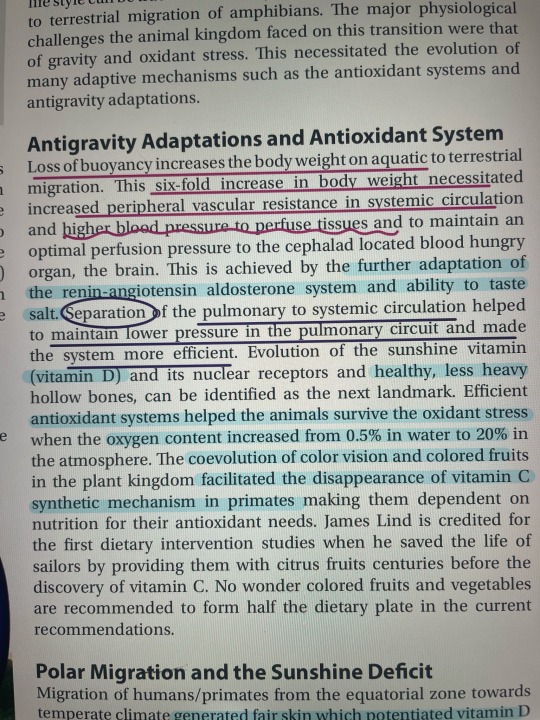
19.07.2023
Back to studying after a huge break. Did some reading on cardiology and made cardiac embryology notes. Went on a date with boyfriend and had some good Thai food.
#phtooftheday#medstudlife#studyblr#studysthetics#neetpg#medstudynotes#neetpg2023#study mood#first aid#inicet#desi doctor#desi academia#light acadamia aesthetic#study blog#indian studyblr#medblog#new medblr#medblr
51 notes
·
View notes
Note
5, 16, and 17 for the ask game!
I reblogged the ask game and then died on the spot (fell asleep) sorry for taking so long
ANYWAY
5 - duel song: Very very hard choice, but I’ve always been partial to Virtual Star Embryology
16 - Character or relationship headcanon you like: Character headcanons-wise, besides what I’ve already spoken about somewhat recently Kozue is soooo not cis. Silly relationship headcanon (also applies to 17) is that everyone keeps formal clothes on hand for Juriori’s weddings because of how often they get divorced and remarried, legal or otherwise
17 - post-canon headcanons: On the more serious side, I hc that after Anthy gets out there’s a solid year of everything going to shit at Ohtori and the remaining cast having to navigate a school that is literally physically falling apart while Akio rots in his office. On a less serious note, Utena and Anthy both realize that they are mildly allergic to roses.
#revolutionary girl utena#shoujo kakumei utena#rgu#sku#utena tenjou#anthy himemiya#kozue kaoru#juriori#utena headcanons#ohtoriposting#wild animal delivery
7 notes
·
View notes
Note
i know the theory of evolution has been used to justify eugenics but what do you mean it's tied to pseudoscience (besides pop science and racist understandings of it)? and like, what are the actual alternatives then?
evolution as in the actual phenomenon cannot & does not affirm the idea that certain ways of being, behaviours, bodies, etc. are ���degenerate” or “primitive” but the theory can and was applied in this pseudoscientific way (ie social darwinism). so what i am referring to is pseudoscientific applications of evolution such as “race science” (which we referred to racial pseudoscience or race pseudoscience in some of my upper level classes in my degree).
i wrote a whole big reply but i went back to steven angelides and he explains it best.
note, bisexual was initially coined (krafft-ebing. 1886) to refer to intersex individuals and bisexuality was referred to as “psychic h*rmaphroditism” (cw for use of h slur)
The newly emerging registers of sex/gender and sexuality were inextricably entwined through the hegemonic discourse of evolutionary theory. Determined to reorder dominant social hierarchies, scientists explained deviations of normative being and behavior in terms of a hetero-teleological scale of evolutionary development. Blacks, homosexuals, children, and women were situated at lower points on this scale than white heterosexual men, not able (or not yet able) to reach the highest stage of (hu)man evolution. The category of bisexuality played a central role in this linear model, and thus in the epistemological configuration of the category of sexuality (Angelides, 2001). The human differences of race, age, gender and sexuality were thought to be the effect of a specific temporal and spatial relation to what evolutionists and sexologists referred to as primordial hermaphroditism or embryological bisexuality. Believed to be the earliest form of human ancestry, primordial hermaphroditism, or bisexuality, as Frank Sulloway (1979, p. 179) points out, became the evolutionists “missing bisexual link.” This was confirmed by recapitulation theory, which posited that the human embryo repeated “in its own life history the life history of the race, passing through the lower forms of its ancestors on its way to maturity” (Russett, 1989, p. 50). In other words, as Charles Darwin (1927 [1871], p. 525) posited, every individual “bears rudiments of various accessory parts, appertaining to the reproductive system, which properly belong[s] to the opposite sex.” This meant that blacks, women, children and homosexuals were thought to be the effect of an unsuccessful evolution, closer to, or retaining many more elements of, the originary (pre-historic) bisexuality of the human race and individual embryo. Put differently, an individual’s distance from this state of primordial bisexuality dictated the degree of one’s evolutionary advancement. Within this framework, therefore, the axes of race, age, gender and sexuality were defined and aligned by their very relation to bisexuality.
However, bisexuality posed a problem for sexological discourse. In the attempt to catalogue human sexual behavior, sexologists were con- fronted with the dilemma of containing its variant forms within the nascent and rigid oppositional categories of hetero- and homosexuality. After all, even in his 1897 publication, Sexual Inversion, Havelock Ellis (1897, p. 133) acknowledged the “person who is organically twisted into a shape that is more fitted for the exercise of the inverted than of the normal sexual impulse, or else equally fitted for both” (emphasis added). Similarly, Krafft-Ebing (1965, pp. 373-385) had identified what he called “psychical hermaphroditism.” Yet, sexology was unable to account for bisexuality as a form of sexuality. For instance, on the one hand, Ellis (1928 [1901], p. 88) claimed that “[t]here would seem to be a broad and simple grouping of all sexually functioning persons into three comprehensive divisions: the heterosexual, the bisexual, and the homosexual.” Yet, on the other hand, he affirmed like Krafft-Ebing, that “[m]ost of the bisexual prefer their own sex . . . [and that this] would seem to indicate that the bisexuals may really be inverts.” “In any case,” stated Ellis (1928 [1901], p. 278), “bisexuality merges imperceptibly into simple inversion.”
The difficulty for sexologists constrained by a linear logic of temporal succession was how to reconcile bisexuality as at one and the same time a biological cause (embryological bisexuality) and a psychological effect (bisexual identity). Ultimately, bisexuality as a form of sexuality or identity had to be refused in the present tense.5 That is to say that bisexuality always had to be somewhere else–in the embryo, the sphere of human prehistory–or something else–either really heterosexual or homosexual. It could never be a stable sexual identity in the here and now otherwise the epistemological integrity of the very categories of man, woman, heterosexual and homosexual would be thrown into doubt (Angelides, 2001).
steve angelides, historicizing bisexuality p. 130-132
26 notes
·
View notes
Photo


#studyblr#notes#medblr#medical notes#med notes#maternal effect#genetics#maternal effect notes#genetics notes#biology#biology notes#bio#bio notes#transitory maternal effect#permanent maternal effect#embryonic development#embryology#embryology notes#development#development notes
4 notes
·
View notes
Text
I was tagged by @radaghastly to list 5 topics I can talk on for an hour without preparing any material.
Medical lab science, particularly microbiology and hematology
sea urchin embryology and development (though it's been a hot minute, I would need to review my notes from college so idk if this one counts lol)
Norwegian black metal
carbonaceous biochemical oxygen demand (a type of testing I did at one of my previous labs)
magic the gathering-- mostly from a game play standpoint, I don't really keep up with the lore
tagging @bumblebee-bard, @coucan, @the-night-wizard, @farewell-persephone, @scarsoftheshatteredsky, and @kladivonacarodejnice
No pressure to post
8 notes
·
View notes
Text


6th July 2023 // Thursday
Day 5
Studied the anatomy of heart , practiced writing the long note , didn't finish the whole thing though.
Also read embryology:
Development of digestive system :
Foregut
Development of Oesophagus + Anomalies
Development of Stomach
Development of Liver
Developmeng of Pancreas + Anomalies
#studyblr#productivity#study motivation#study blog#study hard#med school#stdyblr#aesthetic#studtblr#study inspiration#productivity challenge#study challenge#medical school#med studyblr#medical studyblr#med student#medblr#medical student#medschool#medstudent#medblog#study community#study space#study inspo#work hard#dailymotivation#15 day study challenge#15 days of productivity#academia aesthetic#study aesthetic
28 notes
·
View notes
Text
15 - 05 - 2023


I studied Anatomy in the morning and Embryology in the afternoon, and I've got to say, I'm finally really liking it. I used to hate this subject because I studied it from seminars and didn't quite get it, and always felt more lost than I should. Now I grabbed the book and read it as if I'm reading a story, colorcoding everything, doing notes with a thousand pretty post-its and I've finally come to terms with it. I always liked genetics and hormones so it's been a smooth ride ever since.
I'm having some trouble memorizing in anatomy, though. I feel I've reached a point where no matter how much I take in, it gets out. I'm trying out new ways of studying but some facts are always slipping off! It's frustrating. But I'm near the first exam and I should be fine by then. I trust myself, I'm studying hard. I can do it!
#book#bookish#bookblr#booklr#books#bookworm#bookstagram#dark academic#first year medshool#med school#fmed#studyblr
51 notes
·
View notes
Note
Hey! I'm about to start my medical college journey & am a little confused about the books to read in the first year. Could you please help me? I looked thru your blog & it seems like at your uni they follow a pattern and timeline similar to the Indian medical system, so I thought I'd pop by & ask you for some advice :)
PS: Love your blog, really inspirational!! 🩵 I'm a ex-French learner myself & your posts really inspire me to restart.
Hey, first of all, congratulations and welcome to the Fraternity!
As for the books:
Anatomy
General anatomy : get the bdc or vishram singh general anatomy pdf or get the book from library once you are in college and give a read to important topics and go through the terminologies. You can read general anatomy now, before you go to college or during your foundation course classes
Gross anatomy : The preferred book by students is BDC but i read vishram singh. It has very easy to remember diagrams and things are given in points, i suppose you will feel easier to understand and remember. May be, you can go to a store and see both books and decide (goes for all the books, I'll write here about my personal experience only)
Embryology : Get a langman from senior or if it is okay, buy it too. It's an international book but quite good. You don't have to go through everything but the important topics. Vishram singh embryology is also nice. I got to know about it just few days before exam but it was nice. And please don't neglect embryology. Your friends and seniors will say that it doesn't matter, it does. I suppose i could have got distinction in anatomy if only i had read embryo properly since in paper 1, i couldn't write one answer at all. (Like distinction is not everything, it's just kind of an achievement that can boost you?)
Histology : we read IB singh and mostly, our class notes.
Osteology : Again, class notes. But i guess, poddar is being followed here. I had the pdf. So, see if your college has good teacher who teaches you well, take notes of the bones and revise them. Well, vishram singh gross books also have bone sections and its quite nice.
Physiology
Guyton is the best book. If it is possible for you, get that book either from a senior or from a store. Seniors will tell you otherwise most of the time unless you are in AIIMS or the top colleges. Don't listen to them. I regret not studying standard books, they are gem. But you have to start from initial days and again, make notes of important topics. For exam purpose, you can read your notes and Sembulingam. Thats a nice book. You can keep a pdf. We used AK jain too. But in case you are reading Guyton, making notes and using Sembu, you don't need it. And get the AK jain practical book.
Biochemistry
The standard books are Lippincott and Harper. They are review books. Other than that we followed Satyanarayan or Vasudevan. Satyanarayan is better for exams i feel. Since its like a note. You can keep one of them as physical book and other as pdf. Keep whatever pdf you get actually. And as you proceed, you will get to know about more study materials like Jambulkar. That's nice note but use that as a revision tool.
In our college, for practical in biochemistry, we real our practical copies only. So, i have no idea what other colleges follow for practical
Do join telegram channels, you will get whatever pdf you need and important topics. I will suggest you to read every topic but make notes or proper annotation of important topics and of course, revision of them.
That's all i can remember now. Its not like you need to buy all the books right now itself. See those books in library or get the pdfs and go through random topics and whatever you feel nice, you can buy it. And as i said, keep all pdfs. Mbbs is not like preparing for neet. There will be topics easier to understand or easier to present in exam in different book than yours. But you cannot buy all books so pdf works. And do feel free to ask whatever doubt you have!
PS : This means a lot, thank you! And you can definitely restart your language lessons too.
2 notes
·
View notes